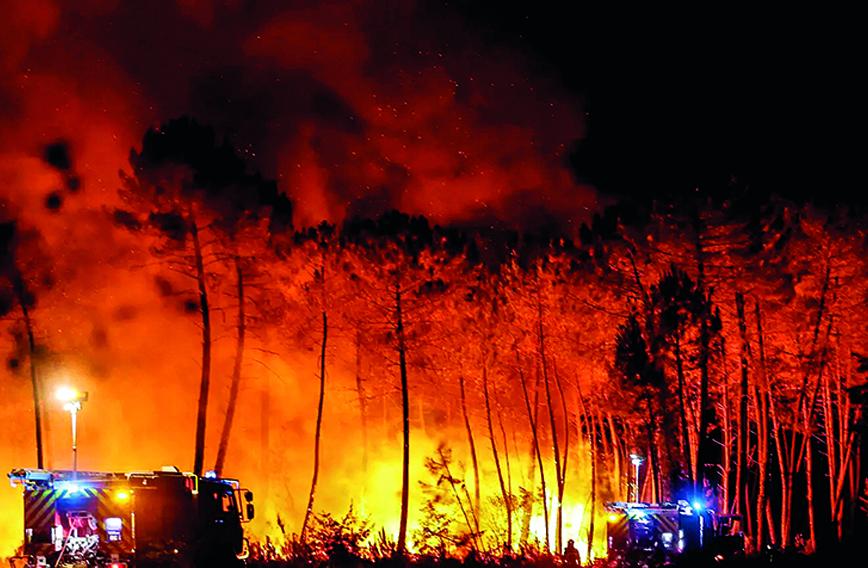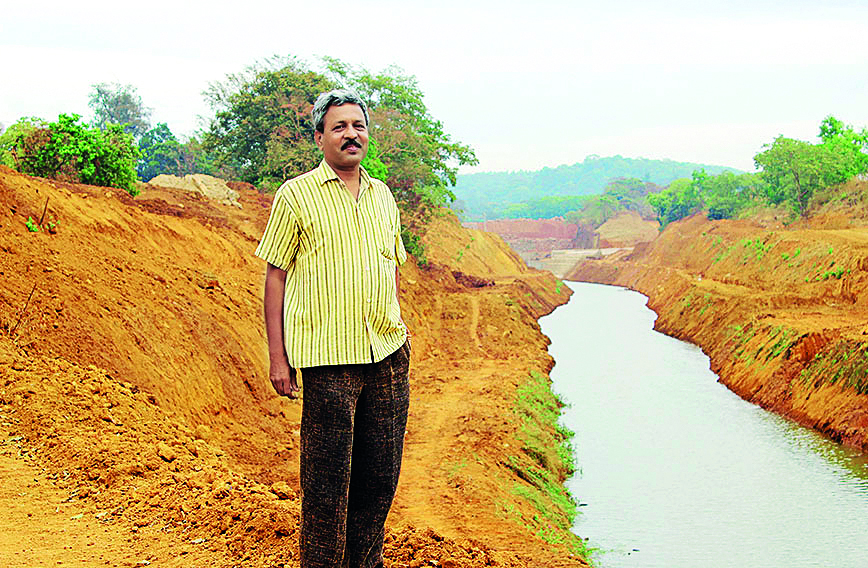
A raging fire and, below, a Navy helicopter deployed for firefighting
Tree count after fires. But who’s to blame in Goa?
Derek Almeid, Panjim
WITH the monsoons due to arrive in June, the Forest Department of Goa is gearing up to restore 442 hectares of forest destroyed by fires in March. Although forest fires are not new to Goa, the intensity this year and the quantum of damage took the department and the state by surprise.
Chief Conservator of Forests (CCF) Saurabh Kumar told local media that identification of trees destroyed by fires is underway and similar trees will be planted to restore the forests.
A probe conducted by the department concluded that most of the fires started in cashew plantations and spread to the forests. Reading between the lines, this means that most of the fires were man-made and were probably the result of attempts to burn dry leaves on plantation floors. Given the unprecedented weather conditions this year, it is no wonder the flames spread rapidly.
The fires were first noticed on March 5 in the Mhadei Wildlife Sanctuary and by March 10 about 74 sporadic fires were burning in the forest. Until now Goa’s worst experience with forest fires was probably 2019-20 when 34 fires burnt down 232 hectares of forest. The following two years saw destruction of 87 and 51 hectares, respectively. But this year 442 hectares were destroyed.
When one considers that nearly two-thirds of Goa is covered by forests, the quantum of forest area affected by fires is relatively small. The reason is that tropical rainforests don’t burn down easily.
However, predictions made by climate change scientists have spooked everyone — with the general perception that the worst is yet to come. Hence, the state moved quickly to douse the fires once they started. Naval helicopters flew several sorties and poured more than 25,000 litres of water in remote and inaccessible forest areas to douse the flames.
Midway through the firefighting effort, the government called upon volunteers and 10 to 15 of them were assigned per beat to work in shifts. This was necessitated due to the nature of the terrain which prevented the movement of firefighting machinery. North Goa Collector Mama Hage’s circular said the government was looking for physically fit people because it would involve walking through the jungle, sometimes at night.
The forest department also issued an SOS calling for volunteers in Satteri and Mollem regions of the Mhadei sanctuary. Within a few hours hundreds had signed up and a massive community-based firefighting effort was underway. Volunteers helped the forest department as fire beaters, in clearing dry vegetation, creating fire breaks and lighting counter fires.
Eleven days later, all the fires had been put out and Goa heaved a collective sigh of relief. It had been the most trying 11 days for the state and now plans are being made to ensure that such fires do not recur. If they do, the state will try to be better prepared to deal with them.
The forest and fire departments, state administration and community came together to contain the fires and ensure that only a small portion of the forest area was affected.
Goa comprises 3,702 sq km of which 2,219 sq km are covered by forests. The remainder is agricultural land and settlement zones. The forest area destroyed by fires this year is roughly 4.42 sq km. In other words, a great deal was saved.
When the fires broke out there was speculation that they had been started by vested interests to prevent parts of the Mhadei Wildlife Sanctuary from being converted into a tiger habitat. State Forest Minister Vishwajit Rane went on record to state that the fires were man-made. About 34 First Information Reports were lodged with the police, mostly against unknown persons, under the Indian Forest Act, 1927, the Wildlife (Protection) Act, 1972, the Goa, Daman, and Diu Preservation of Trees Act, 1984, and relevant provisions of the Indian Penal Code.
However, activists in the state are sceptical about the government’s seriousness in apprehending those who started the fires.
In the Assembly, Leader of the Opposition Yuri Alemao labelled the fires as the handiwork of the ‘fire mafia’ who, he claimed, were using fire to burn down green areas to later convert them into concrete jungles. Alemao called for an inquiry by a retired high court judge.
The fires caught the government on the wrong foot and it has two suspicions to dispel. First, that the forests are being set ablaze to favour the building lobby and, second, that it is working hand-in-glove with this lobby.
It is in this respect that the CCF announced a slew of measures. The department widely believes that many of the fires originated in the horticulture plantations due to indiscriminate burning of leaves and dry grass to clear the ground. The department will work in tandem with the agriculture department to propagate biowaste management outside forest areas.
If there is one crucial lesson that the state government learnt from the March fires it is that it has to look at more effective measures to put out fires since the locations are not reachable by regular firefighting machinery. Accordingly, the department will invest in shoulder-mounted leaf blowers to create fire lines and put out blazes. Additional watch towers are also in the offing.
The CCF also revealed that the department has GPS coordinates of every patch destroyed by the fires and the same species of trees will be planted so that the nature of the forest does not change.
The real story of how or why the fires started might never be known, but the forest department is evidently gearing up to prevent a similar disaster in future.
---------------------------------

‘Villagers burning forests for land’
SPEAKING to Civil Society, Rajan Kerkar, an environmental activist who lives in the vicinity of the Mhadei Wildlife Sanctuary, explained the possible connection between villagers demanding forest rights and the recent fires.
Q: When the fires broke out you told local media that villagers whose forest rights claims are yet to be settled have been clearing forests to expand the area for horticulture. Could you elaborate?
In 1999, the Mhadei region of Sattari, owned by the Goa government, was notified as a wildlife sanctuary. However, in some of these areas, locals have been claiming rights. In land records, the names of some villagers are mentioned as encroachers, and this has made it difficult to settle claims. Even after 1999, the blind eye turned by the Forest Department encouraged encroachments. To bring these areas under cultivation, forest areas are cleared by lighting fires. Villagers who are allowed to go scot-free due to political interference have been engaged in starting forest fires.
Q: So you think that the forest fires are related to the conflict over forest rights?
In many cases, it has been clearly revealed that the forest fires were man-made and intentionally done with the motive of clearing the forest to bring more and more areas under cashew and other horticultural crops. If the government were to appoint a committee to probe the matter, impartially, through field visits, these illegalities will come to light.
Q: What is the connection between forest dwellers and the movement to declare Mhadei Wildlife Sanctuary a tiger reserve?
As per the Scheduled Tribes and Other Traditional Forest Dwellers Act of 2006, the Goa government should have taken necessary steps to settle the forest rights claims of those who are in possession of the land when or before these areas were notified as a wildlife sanctuary. However, even this year, encroachments have been going on unnoticed, destroying wildlife, ecology and environment. The forest staff are mere spectators, unable to take any concrete steps to halt the ongoing degradation.
Most concerned states have declared forested areas as tiger reserves for maintaining water security. For an ecologically fragile state like Goa, it is the need of the hour to notify areas of Mollem National Park including forested areas of Mhadei and Mahavir Wildlife Sanctuaries as a tiger reserve, excluding all areas of agricultural and horticultural fields, if any.
Comments
Currently there are no Comments. Be first to write a comment!





